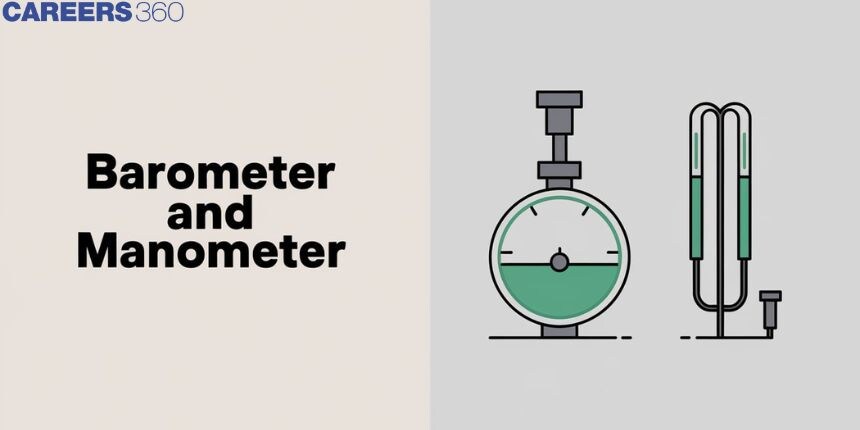Barometer And Manometer
Barometers and manometers are essential tools in understanding and measuring pressure in various contexts, from weather forecasting to industrial applications. A barometer measures atmospheric pressure, helping meteorologists predict weather changes by indicating high or low-pressure systems. In everyday life, this is seen when a drop in atmospheric pressure might signal an approaching storm. On the other hand, a manometer is used to measure the pressure of gases or liquids in a closed system, often utilized in laboratories or industries to ensure the proper functioning of equipment. For instance, in car engines, a manometer can help monitor the pressure in fuel lines to maintain optimal performance. Both instruments, though different in their applications, play crucial roles in ensuring safety, efficiency, and accuracy in various real-life scenarios. In this article, we will cover the concept of Barometer And Manometer. This concept falls under the broader category of Properties of Solids and Liquids.
This Story also Contains
- Barometer and Manometer
- Solved Examples Based on Properties of Solids and Liquids
- Summary

Barometer and Manometer
Barometers and manometers are crucial instruments used to measure pressure, but they serve different purposes. A barometer is designed to measure atmospheric pressure, which is vital for weather forecasting and predicting changes in weather patterns. For example, when the barometer indicates a drop in pressure, it often signals that a storm or rain is approaching. In contrast, a manometer measures the pressure of gases or liquids in a contained environment, making it essential in fields like engineering, medicine, and industry.
Let's Discuss one by one
Barometer
A barometer is an essential instrument used to measure atmospheric pressure, a key factor in weather forecasting. By detecting changes in air pressure, barometers can help predict shifts in the weather, such as the approach of a storm or clear skies ahead. For instance, a sudden drop in barometric pressure often indicates that a storm is on the way, while a rise suggests fair weather. Beyond meteorology, barometers also play a role in various scientific experiments and are used in activities like altitude measurement in hiking or aviation. Mercury Barometer was invented by Torricelli and it is a device used for measuring pressure.
Below is a figure showing the Mercury Barometer device

From the figure, we can say that
At Point C only atmospheric pressure is there.
so
And since B and C are at the same horizontal level
so
For mercury barometer
And using
We get
Manometer
A manometer is a device used to measure the pressure of gases or liquids within a closed system. It is widely employed in various industries, laboratories, and even household applications to ensure that pressure levels remain within safe and optimal ranges. Manometers are devices used to measure the gauge pressure of fluids.
Simple Manometer
The figure of the Simple Manometer is given below

From the figure, we can say that
The gauge pressure at point A in the vessel is
Where
U-tube Manometer
The figure of the U-tube manometer is given below

From the figure, we can say that
The gauge pressure at point
Where
Recommended Topic Video
Solved Examples Based on Properties of Solids and Liquids
Example 1: An inverted U-tube manometer shown in the figure is used to measure the difference in water level between the two tanks. Calculate this difference between the water level for the conditions indicated.(Find in cm )

1) 4
2) 2
3) 3
4) 8
Solution: The inverted U-tube manometer is used for finding. the difference in water level in the two tanks. Draw a horizontal straight line passing through the lower-level and upper-level liquid in the manometer as shown in Figure. Starting from the top of Tank 2 and moving through the tube and reaching the top of Tank 1, the manometric equation can be written as

Hence, the answer is the option (1).
Example 2: Find out the value of

1)
2)
3)
4)
Solution:
Pressure at
Pressure at
But
Hence,
Hence, the answer is the option (1).
Example 3: The value of g at a place decreases by 2%. The barometric height of mercury
1) increases by 2%
2) Decreases by 2%
3) Remains unchanged
4) Sometimes increases and sometimes decreases
get
Solution:
If g decreased by
Hence, the answer is the option (1).
Example 4: A barometer kept in a stationary elevator reads 76cm. If the elevator starts accelerating the reading will be:
1) Zero
2) equal to 76
3) more than 76
4) less than 76
Solution:
Barometric pressure = $\rho$gh
geff = g+a
With the increase in g, reading h will decrease.
Hence, the answer is the option (4).
Summary
In summary, barometers and manometers are vital instruments for measuring pressure, each serving distinct purposes. Barometers measure atmospheric pressure, crucial for weather forecasting, while manometers measure the pressure of gases or liquids in closed systems, essential in various industries and scientific applications. Understanding these devices and their principles allows for accurate predictions, efficient system operations, and the safe handling of fluids in diverse contexts.